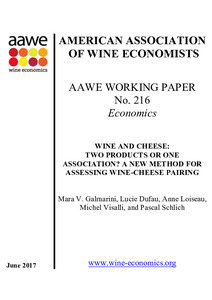Por favor, use este identificador para citar o enlazar este ítem:
https://repositorio.uca.edu.ar/handle/123456789/5447| Título: | Wine and cheese : two products or one association? : a new method for assesing wine-cheese pairing | Autor: | Galmarini, Mara Virginia Dufau, Lucie Loiseau, Anne Laure Visalli, Michel Schlich, Pascal |
Palabras clave: | VINOS; QUESO; ANALISIS ORGANOLEPTICO; PANEL SENSORIAL; CONSUMO DE BEBIDAS ALCOHOLICAS | Fecha de publicación: | 2017 | Editorial: | American Association of Wine Economics | Cita: | Galmarini, M.V. Dufau, L. Loiseau, A. Visalli, M. and P. Schlich. Wine and cheese: two products or one association? : a new method for assesing wine-cheese pairing [en línea]. AAWE Working Paper No. 216 – Economics, 2017. Disponible en: https://repositorio.uca.edu.ar/handle/123456789/5447 | Resumen: | Abstract: The aim of this study was to identify which attributes impacted the dynamic liking of cheese and wine individually as well as when consumed together. Three wines (a white one, Pouilly Loché; and two red ones Maranges and Beaujolais) and three cheeses (Comté, Époisses, Chaource) were individually evaluated by a group of 60 consumers using monointake Temporal Dominance of Sensations (TDS) with simultaneous hedonic ratings. The same data acquisition screen was used for all products showing a unique list of 14 descriptors (covering cheese and wine perception) and a hedonic scale for dynamical rating of liking. The dynamic hedonic data was associated to the TDS profiles obtaining Temporal Drivers of Liking (TDL). The nine wine-cheese associations were evaluated by multi-bite and multi-sip TDS, consumed in a free manner. Individually, Chaource had practically no TDL, in Comté mushroom flavor was a positive TDL, and in Epoisses salty was a negative TDL. All wines presented TDL, but negative were only present in the red ones: bitter, sour and astringent. In wines, the positive TDL were: fruity, spicy and woody. Dynamic perception changes had a bigger impact on liking in wine compared to cheese. For the associations, the negative TDL were only three and mostly wine related: sour (for 7/9 combinations), bitter (6/9) and astringent (5/9). Positive TDL were more varied (a total of 10 descriptors) and were related either to wine or cheese. As opposed to what was found in cheese alone, salty was a positive TDL in two of the combinations. It was observed that the dynamic sensory perception had a more important impact on liking in wine-cheese combinations than when consumed separately. This shows that TDS and TDL have a big potential in the study of food pairing which should be further exploited. | URI: | https://repositorio.uca.edu.ar/handle/123456789/5447 | Disciplina: | CIENCIAS AGRARIAS | Derechos: | Acceso Abierto | Fuente: | American Association of Wine Economics Working Paper No. 216 – Economics, 2017 |
| Aparece en las colecciones: | Artículos |
Ficheros en este ítem:
| Fichero | Descripción | Tamaño | Formato | |
|---|---|---|---|---|
| AAWE_WP216.pdf | 1,02 MB | Adobe PDF |  Visualizar/Abrir |
Visualizaciones de página(s)
92
comprobado en 30-abr-2024
Descarga(s)
99
comprobado en 30-abr-2024
Google ScholarTM
Ver en Google Scholar
Este ítem está sujeto a una Licencia Creative Commons

